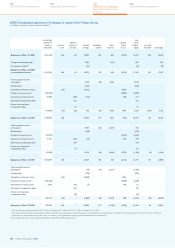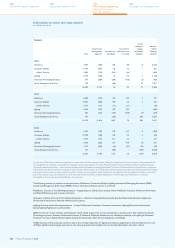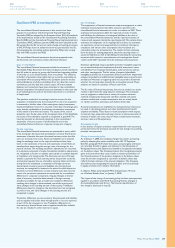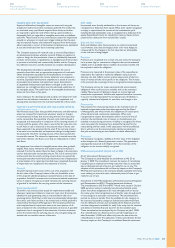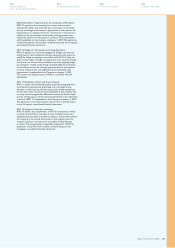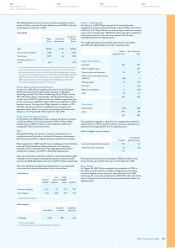Philips 2008 Annual Report Download - page 212
Download and view the complete annual report
Please find page 212 of the 2008 Philips annual report below. You can navigate through the pages in the report by either clicking on the pages listed below, or by using the keyword search tool below to find specific information within the annual report.
discounts given or agreed. The present value of estimated future cash
flows is determined through the use of allowances for uncollectible
amounts. As soon as individual trade accounts receivable can no
longer be collected in the normal way and are expected to result in
a loss, they are designated as doubtful trade accounts receivable and
valued at the expected collectible amounts. They are written off when
they are deemed to be uncollectible because of bankruptcy or other
forms of receivership of the debtors. The allowance for the risk
of non-collection of trade accounts receivable takes into account
credit-risk concentration, collective debt risk based on average
historical losses, and specific circumstances such as serious adverse
economic conditions in a specific country or region.
In the event of sale of receivables and factoring, the Company
derecognizes receivables when the Company has given up control
or continuing involvement.
Long-term receivables are initially recognized at their present value
using an appropriate interest rate. Any discount is amortized to
income over the life of the receivable using the effective yield.
Investments in equity-accounted investees
Investments in companies in which the Company does not have the
ability to directly or indirectly control the financial and operating
decisions, but does possess the ability to exercise significant influence,
are accounted for using the equity method. Generally, in the absence
of demonstrable proof of significant influence, it is presumed to exist
if at least 20% of the voting stock is owned. The Company’s share of
the net income of these companies is included in results relating to
equity-accounted investees in the consolidated statements of income.
When the Company’s share of losses exceeds its interest in an
equity-accounted investee, the carrying amount of that interest
(including any long-term loans) is reduced to nil and recognition of
further losses is discontinued except to the extent that the Company
has incurred legal or constructive obligations or made payments on
behalf of an associate. Unrealized gains on transactions between the
Company and its equity-accounted investees are eliminated to the
extent of the Company’s interest in the associates. Unrealized losses
are also eliminated unless the transaction provides evidence of an
impairment of the asset transferred.
Investments in equity-accounted investees include loans from
the Company to these investees.
Investments in equity-accounted investees also included goodwill
identified on acquisition, net of any accumulated impairment loss.
Accounting for capital transactions of a consolidated subsidiary
or an equity-accounted investee
The Company recognizes dilution gains or losses arising from the
sale or issuance of stock by a consolidated subsidiary or an equity-
accounted investee in the income statement, unless the Company or
the subsidiary either has reacquired or plans to reacquire such shares.
In such instances, the result of the transaction will be recorded
directly in equity.
The dilution gains or losses are presented in a separate line in the
income statement if they relate to consolidated subsidiaries. Dilution
gains and losses related to equity-accounted investees are presented
under ‘Results relating to equity-accounted investees’ in the
consolidated statement of income.
Other non-current financial assets
Other non-current financial assets include available-for-sale securities,
held-to-maturity securities, loans and cost-method investments.
The Company classifies its investments in equity securities that have
readily determinable fair values as either available-for-sale or for
trading purposes. Trading securities are acquired and held principally
for the purpose of selling them in the short term and are presented
as ‘Other current assets’. Trading securities are recorded at fair value
with changes in the fair value recorded in financial income and expense.
Held-to-maturity securities are those debt securities which the
Company has the ability and intent to hold until maturity. Held
to-maturity debt securities are recorded at amortized cost, adjusted
for the amortization or accretion of premiums or discounts using
the effective interest method.
All securities not included in trading or held-to-maturity are classified
as available-for-sale. Available-for-sale securities are recorded at fair
value. Unrealized holding gains and losses, net of the related tax
effect, on available-for-sale equity securities are reported as a separate
component of equity until realized. Realized gains and losses from
the sale of available-for-sale securities are determined on a first-in,
first-out basis. For available-for-sale securities hedged under a fair
value hedge, the changes in the fair value that are attributable to the
risk which is being hedged are recognized in the income statement
rather than in equity.
Loans receivable are stated at amortized cost, less the related
allowance for impaired loans receivable.
Investments in privately held companies that are not equity-
accounted investees, and do not have a quoted market price in an
active market and whose fair value could not be reliably determined
are carried at cost.
Impairment of financial assets
A financial asset is considered to be impaired if objective evidence
indicates that one or more events have had a negative effect on the
estimated future cash flows of that asset. In case of available-for-sale
securities, a significant or prolonged decline in the fair value of the
security below its cost is considered an indicator that the securities
are impaired. If any such evidence exists for available-for-sale financial
assets, the cumulative loss - measured as the difference between the
acquisition cost and the current fair value, less any impairment loss
on that financial asset previously recognized in the income statement -
is removed from equity and recognized in the income statement.
If objective evidence indicates that cost-method investments need
to be tested for impairment, calculations are based on information
derived from business plans and other information available for
estimating their fair value. Any impairment loss is charged to the
income statement.
An impairment loss related to financial assets is reversed if and to the
extent there has been a change in the estimates used to determine
the recoverable amount. The loss is reversed only to the extent that
the asset’s carrying amount does not exceed the carrying amount
that would have been determined, if no impairment loss had been
recognized. Reversals of impairment are recognized in net income
except for reversals of impairment of available-for-sale equity
securities, which are recognized in equity.
Inventories
Inventories are stated at the lower of cost or net realizable value,
less advance payments on work in progress. The cost of inventories
comprises all costs of purchase, costs of conversion and other costs
incurred in bringing the inventories to their present location and
condition. The costs of conversion of inventories include direct labor
and fixed and variable production overheads, taking into account the
stage of completion and the normal capacity of production facilities.
Costs of idle facility and waste are expensed. The cost of inventories
is determined using the first-in, first-out (FIFO) method. Inventory is
reduced for the estimated losses due to obsolescence. This reduction
is determined for groups of products based on purchases in the
recent past and/or expected future demand.
Property, plant and equipment
Property, plant and equipment is stated at cost, less accumulated
depreciation. Assets manufactured by the Company include direct
manufacturing costs, production overheads and interest charges
incurred for qualifying assets during the construction period.
Government grants are deducted from the cost of the related asset.
Depreciation is calculated using the straight-line method over the
useful life of the asset. Depreciation of special tooling is generally
also based on the straight-line method. Gains and losses on the sale
of property, plant and equipment are included in other business
income. Costs related to repair and maintenance activities are expensed
in the period in which they are incurred unless leading to an extension
of the original lifetime or capacity.
Plant and equipment under finance leases and leasehold improvements
are amortized using the straight-line method over the shorter of the
lease term or the estimated useful life of the asset. The gain realized
on sale and operating leaseback transactions that are concluded
based upon market conditions is recognized at the time of the sale.
The Company capitalizes interest as part of the cost of assets that
take a substantial period of time to get ready for use.
Philips Annual Report 2008212
180
Sustainability performance
244
Company financial statements
124
US GAAP financial statements
192
IFRS financial statements
Significant IFRS accounting policies




